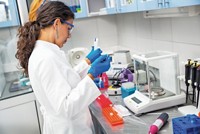Advertisement
Grab your lab coat. Let's get started
Welcome!
Welcome!
Create an account below to get 6 C&EN articles per month, receive newsletters and more - all free.
It seems this is your first time logging in online. Please enter the following information to continue.
As an ACS member you automatically get access to this site. All we need is few more details to create your reading experience.
Not you? Sign in with a different account.
Not you? Sign in with a different account.
ERROR 1
ERROR 1
ERROR 2
ERROR 2
ERROR 2
ERROR 2
ERROR 2
Password and Confirm password must match.
If you have an ACS member number, please enter it here so we can link this account to your membership. (optional)
ERROR 2
ACS values your privacy. By submitting your information, you are gaining access to C&EN and subscribing to our weekly newsletter. We use the information you provide to make your reading experience better, and we will never sell your data to third party members.
Business
Patrick Treado
Nearly two decades of dedication to developing high-tech imaging technology pays off as company continues to grow
by William G. Schulz
August 20, 2012
| A version of this story appeared in
Volume 90, Issue 34
Slow but steady wins the race. For ChemImage cofounder and Chief Technology Officer Patrick Treado, that popular expression captures the arc of his entrepreneurial career so far. Since cofounding the company in 1994, he has overseen the firm’s steady growth and has learned and refined his business skills along the way.
COVER STORY
Patrick Treado
With headquarters in Pittsburgh, ChemImage now employs 80 people. The privately held company develops high-tech hyperspectral imaging systems for defense, forensics, pharmaceutical, and biomedical applications. ChemImage’s technology—based primarily on liquid-crystal imaging technology—enables various materials to be characterized from a microscopic to a macroscopic level, according to company marketing information.
Trained as an analytical chemist, Treado says his first idea for a business came 20 years ago during a postdoctoral fellowship at the National Institutes of Health. There, he explains, he encountered “frustration with the immaturity of tools for optical analysis of disease.” For him, the problem was not the need to develop a particular instrument, but rather the need to develop a technology area to help detect and diagnose disease. At the time, he was thinking of Raman and infrared spectroscopy and imaging.
It wasn’t until 1994, when he was a tenure-track assistant professor of chemistry at the University of Pittsburgh, that Treado began taking steps to become an entrepreneur. It all started when he was approached by nuclear engineering firm Westinghouse, which was looking for a way to monitor and predict failure in working nuclear reactors. “That industrial activity became the seed kernel for the company,” he says. The challenging work, he says, wasn’t about laboratory measurements with Raman technology, but “predictive monitoring” under field conditions.
In 1996, Treado took a leave of absence from the university to focus on ChemImage. Eventually, he left his academic post to further develop the company and its technology. Today, the company’s intellectual property includes some 130 patents.
The Pittsburgh area may not be the best place to raise capital, Treado says, but it “is a great place to start and sustain a technology company.” The area’s major universities and research departments in fields such as computer vision and robotics supply knowledgeable and talented workers. “We have been fortunate to recruit a talented workforce,” he says.
Treado divides the history of his company into three periods. During the first eight years, he explains, the company was a “bootstrapped” R&D organization selling instrumentation and software and existing with the aid of various grants, including an Advanced Technology Program grant from the National Institute of Standards & Technology. Founding the company also required personal sacrifice, he points out. For instance his wife, Carey Treado, a cofounder of ChemImage, put her own academic career as an economist on hold for a period of time to serve as the company’s treasurer and chief financial officer.
During the next eight years, Treado says, he pursued angel investment to raise capital. He learned on the job the best ways to approach private investors, he says. He found it difficult to sell a concept that doesn’t exist to most investors; what really helped was being able to show people the actual technology he wanted to bring to market. Potential shareholders, he says, want to see and understand where their money will go. For raising capital, he advises “talking to as many people who will listen.”
Now in the early part of its third eight years, ChemImage is licensing its technology for forensics and hazardous materials detection and moving into the laboratory services area through a spin-off called Gateway Analytical. The company is still privately held, but it now has some shareholders and a board of directors.
ChemImage
Year founded: 1994
Products: Imaging systems primarily based on liquid-crystal imaging technology
Number of employees: 80
Sources of start-up funds: Government grants/contracts and then private investors
Profiled founder’s current role in company: Chief technology officer
Advice: Pick your path—academic or industrial—and focus on it.
The road ahead for ChemImage continues to be one of manageable growth, a trajectory that has enabled the company’s success and ability to create value for shareholders, Treado says.
“I was presented with a decision—to pursue a career as a tenured academic or turn to an industry career,” Treado says. He advises younger colleagues to consider this decision carefully for themselves. Tenured academics are probably somewhat more risk-averse, he says, and may lack the time for business development.
“It’s not sufficient to hand over a good idea” to advisers, lawyers, and other managers, Treado says. “You have to dig into the gory details. Pick the track you want,” and pursue your dreams and goals.





Join the conversation
Contact the reporter
Submit a Letter to the Editor for publication
Engage with us on Twitter